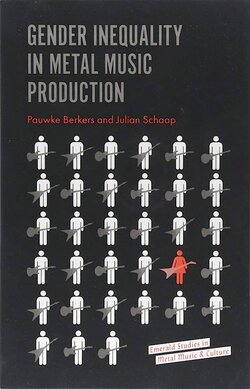
From Amazon:
For over four decades, scholars have been investigating male dominance - both symbolically and numerically -within popular music. The heavier genres of popular music, metal music in particular, have been male dominated spaces, which are difficult to navigate for women participating as fans, musicians, or both. Studies on gender inequality in metal music have convincingly demonstrated how gender dynamics shape the reception of metal music and metal scenes all over the globe. Yet, they shed relatively little light on the extent of and reasons for metal music's male domination from a production perspective. This book fills this gap, offering is a systematic and large-scale overview of gender inequality in metal music production. In other words: how many women - compared to men - are participating in metal bands and what are the causes for the differences in participation?
Review
Drawing on the online Encyclopaedia Metallum: The Metal Archives, interviews, and online materials and interviews by others, the authors investigate how many women are involved in metal music production and the extent of gender inequality in the genre, looking at longitudinal trends and cross-national differences, subgenres within metal, roles in terms of instrumentation, and the degree of recognition between female and male musicians. They develop the concept of gender as a double-edged sword, in which women attract attention for their bands but are often evaluated based on their feminine appearance rather than musical skills, by linking it to theories of tokenism and cultural/structural embeddedness, and provide a theoretical overview to explain gender inequality in metal music production by examining the practices of learning, doing, and evaluating at the levels of society, pop music, and metal. --Annotation (c)2018 "(protoview.com) "
"Gender Inequality in Metal Music Production is a ground-breaking study and definitively proves what 'we' all already knew from anecdotal evidence and personal experience….Metal was, and still is, a male genre. Now, we have statistical proof AND some important analysis about the how and why this phenomena exists. I expect this study to be highly useful for future generations of academics and should be found in better collections, libraries and on university reading lists everywhere." --Metal Rules, 2018
About the Author
Pauwke Berkers is Associate Professor of Sociology of Art and Culture, Erasmus University Rotterdam, the Netherlands. He has published widely on issues of ethic/racial and gender inequality in arts and culture in, among others, Cultural Sociology, Gender and Society, Journal of Gender Studies, Metal Music Studies and Poetics. He is also a member of the International Society for Metal Music Studies.

Julian Schaap is a PhD candidate and lecturer at the Department of Arts and Culture Studies, Erasmus University Rotterdam, the Netherlands. His research focuses on social stratification on the basis of whiteness, race-ethnicity and gender in various cultural fields. His work has been published in journals such as New Media and Society, Popular Communication, Sociologie and Metal Music Studies.






